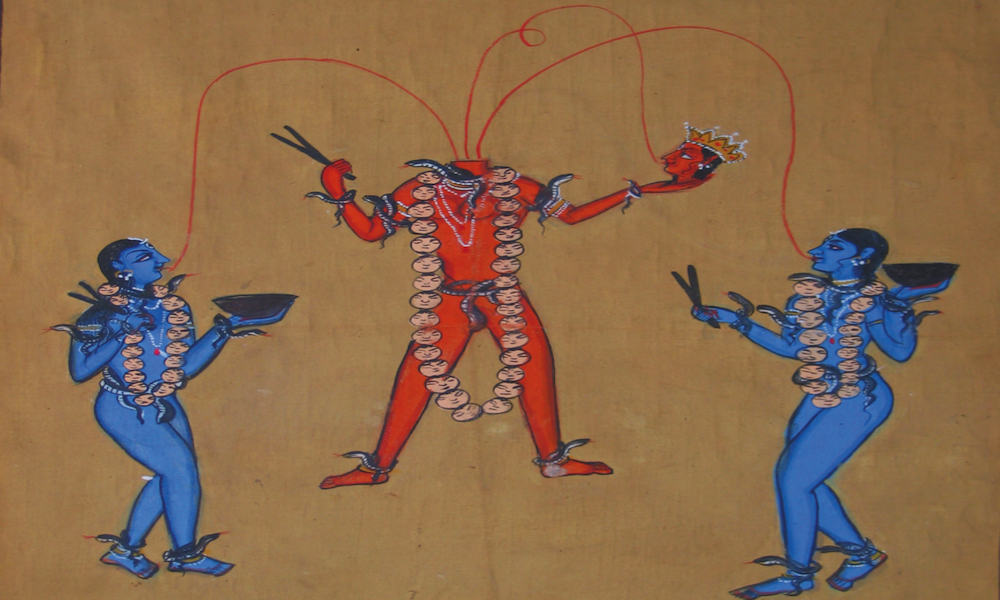
My friend introduced me to the idea that this image of Chinnamasta could be interpreted to refer to the female blood mysteries. The Devi, Chinnamasta has cut off her head and the blood is spurting into the mouths of the other women and her own. This energy, the blood mysteries of menstruation and postpartum, is not a personal one (thus no head) but flows like blood through beings—belonging to no one person

Some say that the married woman, having sindur put in the parting of her hair during the marriage ceremony reflects the fact that now her vagina, vulva (the bleeding) belongs to her husband.
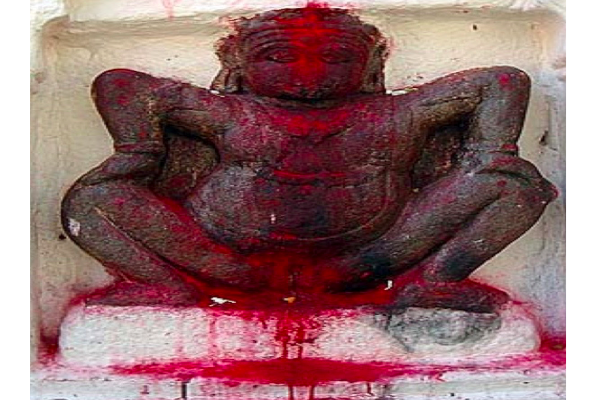
The blood mysteries being honored as sacred from Kamakhya.
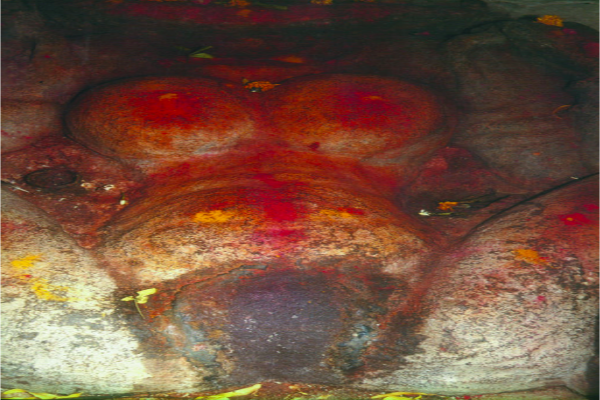
The female body and its capacity to birth has been an object of worship and veneration for eons as you see in this sculpture—daubed with sindur and flowers.
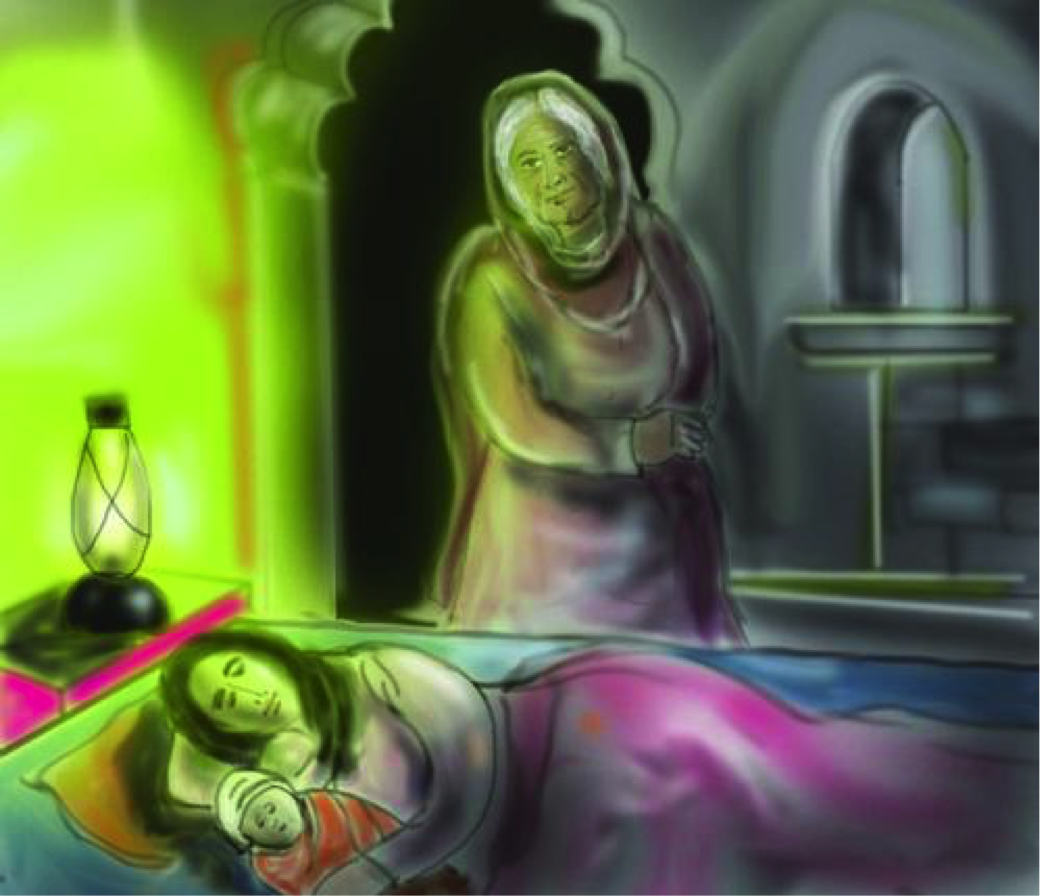
History reveals several stories about those connected with childbirth and childhood, even if considered insignificant by many.
Macduff, the Thane of Fife was pulled out of his dead mother’s womb and lived to kill Macbeth. Akbar the Great was born in the desert of Umarkot after his mother, the teenaged Hamida Banu Begum was helped in the difficult delivery by a faithful midwife. Jahangir had 300 women to share his bed and so a lot of conceptions took place in the harem with subsequent demand for midwives. During Akbar’s reign the seraglio had as its chief matron and nurse, the Portuguese Juliana. The midwife who delivered Salim (Jahangir) is believed to have been the mother of his later sweetheart, Anarkali. Mumtaz Mahal gave birth to 14 children, eight sons and six daughters of whom only four sons and two daughters survived. As a matter of fact, Mumtaz died in her last pregnancy despite the best efforts of the old dai in Burhanpur. During Gardi-ka-Waqt , when the twilight of the Mughals began, licentiousness increased (as per Dr R. Nath) and with it a large number of pregnancies. No wonder dais , wet nurses and lori or lullaby singers were greatly sought after.
In the early 1950s, 88-year-old Rabbo Dai, who lived in Jama Masjid’s fish market of Macchliwalan, used to say that her great-grandmother and grandmother were frequently called to the Salatan or poor quarters of the harem in the fort to deliver babies, treat women after a miscarriage or to carry out abortions, as a result of incestuous liaisons. Jahandar Shah and Mohammad Shah were known for their promiscuity. But the latter was not lax in enforcing rules of propriety for the Salatan . Hence the hush-hush visits of midwives to the fort. Rabbo used to say that an illegitimate child, especially if it was a girl, was suffocated at birth by the midwife on the orders of the family elders to save the mother’s honour and keep the possibility of a decent marriage alive. She claimed that the portion of the fort near the Yamuna, to which a gate leads from below the Rang Mahal and Dewan-e-Khas, was used to either bury the bodies of new-borns in the sand or to throw them into the river.
Such happenings during the time of the puppet emperors were an unfortunate reflection on the problems faced by young men and women who, born of concubines, were a neglected lot. Unable to get married because of poverty, they had to take recourse to either unnatural sex or illicit cohabitation. Midwives usually got a pittance for their labours but there were rich and influential women too in the zenana who paid some handsomely. If Rabbo dai was to be believed, prosperous dais were able to buy houses in the Walled City and become landladies. Their detractors called these properties “haram bacchon ki jaidad” or the property of illegitimate children.
Wet-nurses were in demand for the inmates of the harem as many of them were anaemic and could not produce enough milk for their babies. However, there were also cases of princes preventing their wives from breast-feeding the infants as they thought it would mar their beauty. As Raboo Dai put it, “Which prince would like a woman with sagging breasts?” Talking of wet-nurses, even Akbar had two –– Maham Anga and Jiji Anga. There was intense rivalry between them. Maham Anga’s son Adham Khan was provoked to murder Jiji Anga’s husband, Shamsuddin Atgah Khan, whose mausoleum in situated near Humayun’s Tomb while Adham Khan, who had to pay with his life on the orders of Akbar, is buried in Mehrauli.
Along with wet-nurses, lori singers were also welcomed to sing lullabies to royal babies. They were hired from the city but some were housed in the fort as they had to sing both in the afternoon and night. One popular lullaby was: “Chandan ka hai palna/resham ki hai dor/Aur Kabul se Mughlanian/khadi hilawein dor” (a reference to Pathan women lulling the infants to sleep in gilded cradles). Lories even find mention in Saros Cowasjee’s Anthology of the Raj.
When we were interviewing dais (traditional Indian midwives) about their experiences at births, their techniques, skills and rituals, everyone we interviewed, including one Muslim dai, mentioned Shasti Ma, the goddess of childbirth. The dais talked about how they remembered or invoked her at the time of birth and the postpartum rituals.
I was working on the Jeeva Project in an area called Jharkhand, one of the poorest and most medically underserved parts of India. But this is precisely where dais continue to meet the needs, as best they can, of birthing women—and where younger women continue to learn traditional birth work from the elders in their community.
During one interview, a village woman named Himani Nandi, who was listening to this conversation about birth, told a story about Shasti Ma, which described her link to the more familiar Saraswati, the goddess of knowledge and wisdom, and explained the custom of eating bhassi khanna (or day-old food) on the day after Saraswati Puja. This is not a renowned story, which you would find in fancy books on goddesses and Indian religion, but that’s the beauty of India—each region, each area, has its own mythic narratives.
This is what Himani Nandi told us:
There was one old man. He had 60 sons and that’s why he was known as Sattha (which stands for the number 60 in Hindi). One night he had a dream; and in his dream an old lady asked him to look for brides for his sons and he would find them. The condition is that they should be married into a family that has 60 daughters. He asked the old lady where he would find such a family. The old lady gave him a clue that he should travel to a distant place, where he would fall down—there he would find such a family. The next day, early in the morning, he started his journey. He walked a long distance before tiring and saying, “I don’t know where I will find those 60 girls.” After a rest, he again started his journey. Then he stumbled and fell down.
A woman was washing dishes nearby. Sattha asked that woman if there was any family in her village that had 60 daughters. She replied, “Come along with me. I have 60 daughters.” So Sattha married his sons with those girls and they started living happily together. The Saraswati Puja festival came and they celebrated it. The day after Saraswati Puja, which is known as baasi bhaat (day-old food, with bhaat being a rice dish). According to the custom Sattha’s daughter-in-law offered him baasi bhaat. Sattha had thought that on this day he would eat fresh, hot bhaat. This thought flashed in Sattha’s mind and Shasti Ma heard it while she was in the jungle.
Suddenly it started raining heavily. Water flowed into all the houses and all Sattha’s 60 sons and daughters-in-law died in the flood. Sattha was shocked to see all this. He asked a man who was passing by about the reason for this catastrophe. The man advised him to go to Shasti Ma and ask her. “But where would I find Shasti Ma?” he asked. The old man said, “She lives in bard gachh (a banyan tree), go there.” Then Sattha went to the banyan tree and saw an old lady there. He fell at her feet saying, “You are Shasti Ma?” She said that she was not Shasti Ma, but told him to go to the 60th banyan tree.
When he reached the 60th tree, Sattha saw an old lady whose hair was untied and disheveled and blood and mucus streamed out of her body. She asked the old man to clean her body with his tongue. He did this. When he spat, after cleaning her body with his tongue, with each spit one of his sons appeared before him. In this way all 60 of his sons and his 60 daughters-in-law came alive again. He asked Shasti Ma to forgive him for complaining about the baasi bhaat. This is why baasi bhaat is eaten the day after Saraswati Puja.
One of the first things to notice about this story is that, despite the fantastic events that take place, the locations and activities are common to everyday life. The concerns with finding partners for the children to marry, banyan trees, dreams, travelling (by foot), washing dishes, wise old ladies, bhaat or common food, blood and mucus, and even Sattha’s dissatisfaction with the food his daughter-in-law served him are part and parcel of everyday life.
Another aspect, and this is more relevant to the topic of birth, is the common rhetorical device in Indian tales of displacement of body parts. Let’s look at the images used here. Sattha cleans up the old lady’s blood and mucus with his tongue (phallus?) He spits and a son comes alive (ejaculation?) On one level, this is like Athena being born from Zeus’s head—the male claiming the power to give birth—arrogant, just like Sattha’s dissatisfaction with the food (a not unusual Indian male reaction). On another level, the penis must enter the vagina, place of blood and mucus—those dirty but fertile places in many males’ imaginations—for conception to take place.
But most importantly, I would suggest, is the level of his cleaning up (with that supposedly clean place, the mouth) these oozing bodily fluids. (Anyone who has recently birthed or works with birthing women is very familiar with these fluids!) He has to literally taste this yucky stuff in order to redeem himself of his transgression and the subsequent catastrophe. He needs to gain knowledge about woman’s creative juices. And what is his transgression? He forgot the honouring of Shasti Ma by his disappointment at baasi bhaat and was dissatisfied with his daughter-in-law—the one who will provide him with grandchildren, continuing the family line. The activities of cooking and pregnancy, involving the pot on the stove and the pot in the belly, are often prominent in the Indian imagination. I remember one dai describing labour pain as “the pot is boiling.”
Let’s now look at Shasti Ma and her role in the story. Interestingly, Himani, who told the story, ended by making two points. First, she explained that the dai does Shasti Ma’s worship so on the day of baasi bhaat, this story is told to everyone. She also said that Shasti Ma appears in different forms. Here the identities of Shasti Ma and Saraswati— and even the dai who does her worship—are fluid. Changing roop or shape is what in shamanism is called “shape shifting.”
Theologically, there is nothing about these deities, these stories, which can be defined as mutually exclusive—Saraswati and Shasti Ma and even the dai merge into one another, all signifying, guarding and helping the creative force. The name Shasti is, in Hindi, Srishti, or creation. While writing this article I looked up the meanings of saras, the root of Saraswati, and found that saras means water, which is continually flowing, always new, renewing and flowing and fertile—the seat of all creative streams. In the high traditions, Saraswati is associated with learning, culture and knowledge. It is fitting then that Sattha’s transgression, his neglect of the custom of honouring Saraswati by eating baasi bhaat, results in a flood.
I love this story because it depicts events that are earthy and sacred at the same time. I share this story because it opens up a world view in which the fluids of the female body, and by implication, birth—such a mundane, everyday occurrence—is the central concern.
Janet Chawla gratefully acknowledges her partners in the Jeeva Project (Mira Sadgopal, Lindsay Barnes, Imrana Qadir and Leila Caleb-Varkey) as well as Jan Chetna Manch and the support from Inseime, an Italian filmmakers group, for providing the opportunity to collect and share this information. For more information about the Jeeva Project please send e-mail to [email protected].
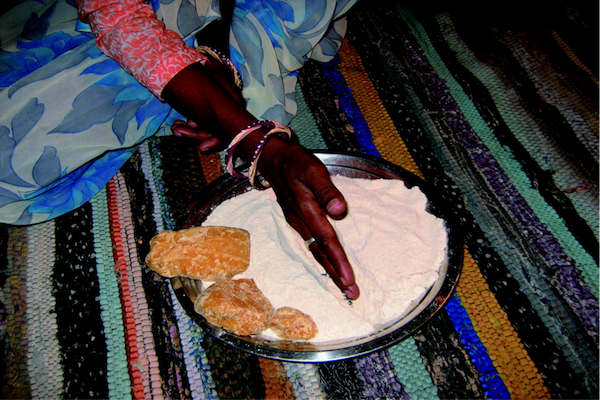
There is the custom of cutting the atta or rice. When the labour pains have come and the dai has arrived, the jachcha puts both hands full ofatta in the thali. The dai holds the wrist of the mother while she, with her hand, separates the atta into two parts from the middle.Bhemata is worshipped by putting money and gur on top of the atta, offering it to the dai, and saying “In this way separate the mother and the child so that the child is born without any difficulty.” It is said that when Ram and Lakshman were born bemata herself came and acted as dai. Now it’s the dai, herself, who represents the shakti of bemata. (Moti Dai—an upper caste midwife)
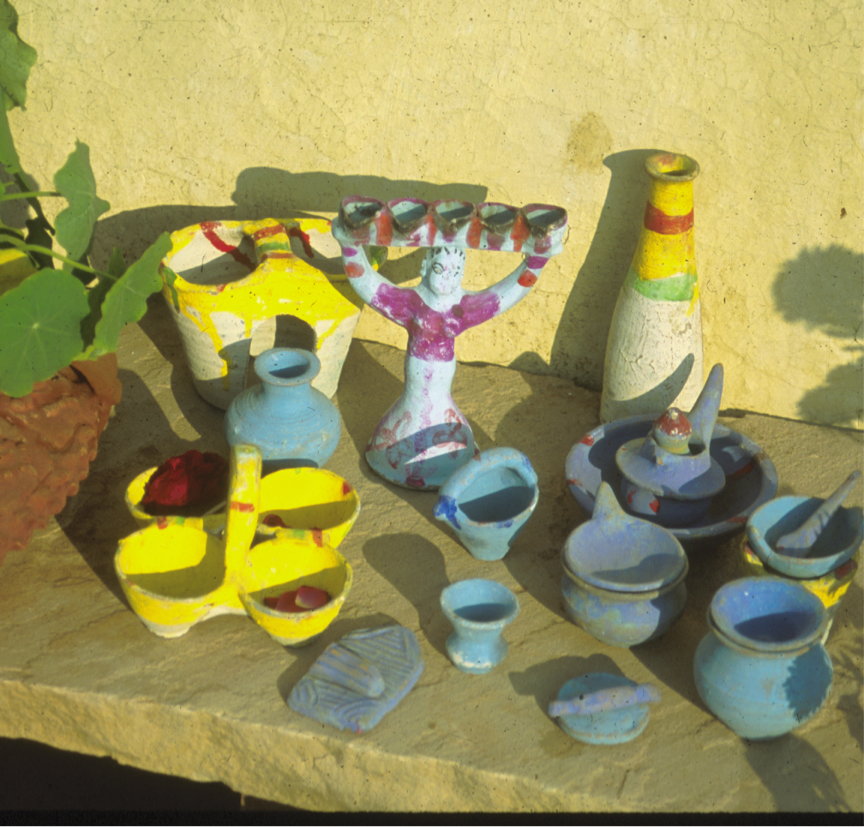
I brought this from Bodhgaya, Bihar many years ago. It is all one needs to do a daayan puja. These clay miniature kitchen tools were part of a set that was available in all the bazaars during Diwali. The dain is in the middle with dias over her head. At that time all castes from Brahmin to outcaste would build a little house on the side of their houses and at dusk a ritual would be done. Sweets and grains would be put by young girls in the bartans and then they would light dias. It was understood that the dain (who could bless you or curse you) would imitate the rite and bless the household with food and sweets during the coming year.
Probably now this rite has been replaced by Lakshmi puja. This all made sense to me because in Delhi we always gave and received different kinds of kitchen implements as gifts during Diwali.
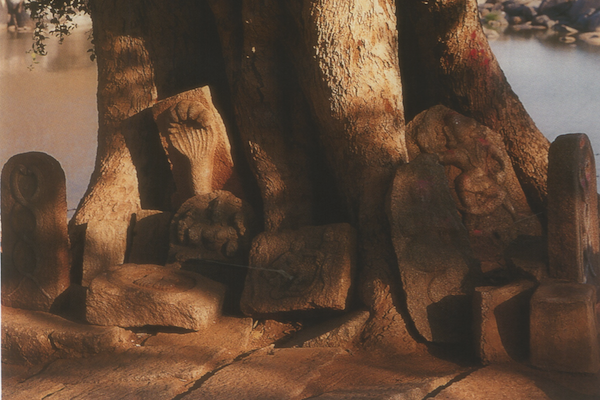
Naga Stones put at the base of a tree in Madurai by a woman who wants to conceive.
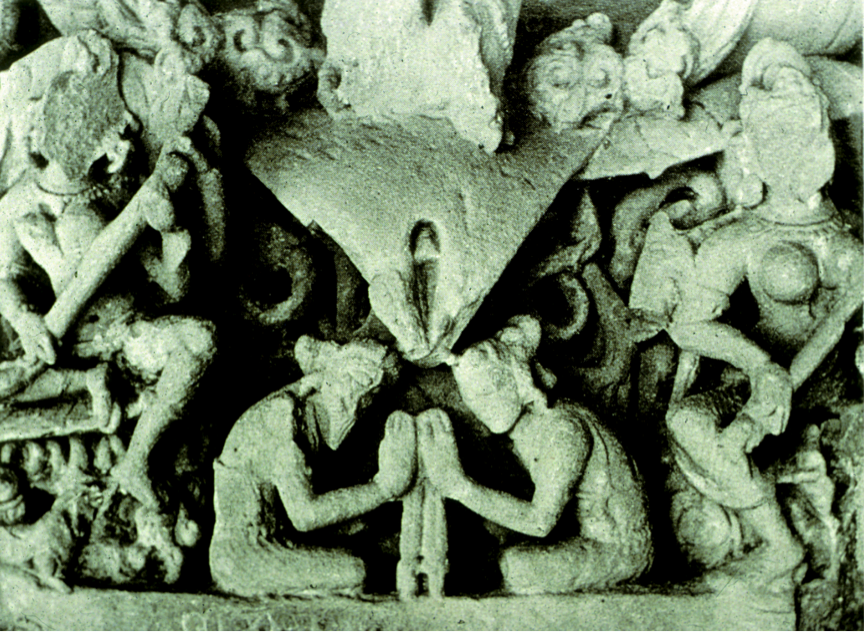
Taken from a Yogini temple in Orissa this image shows a man and a woman bowing and praying to an icon of the vagina. Downward pointing triangles are often imaged as female and in the middle is a little bit that is like a clitoris.
Probably now this rite has been replaced by Lakshmi puja. This all made sense to me because in Delhi we always gave and received different kinds of kitchen implements as gifts during Diwali.